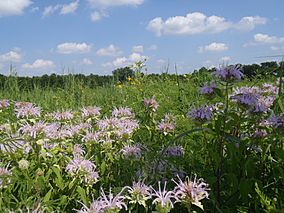Marais des Cygnes National Wildlife Refuge facts for kids
Quick facts for kids Marais des Cygnes National Wildlife Refuge |
|
|---|---|
|
IUCN Category IV (Habitat/Species Management Area)
|
|

Tallgrass prairie at Marais des Cygnes NWR
|
|
| Location | Linn County, Kansas, United States |
| Nearest city | Pleasanton, Kansas |
| Area | 7,500 acres (30 km2) |
| Established | 1992 |
| Governing body | U.S. Fish and Wildlife Service |
| Website | Marais des Cygnes National Wildlife Refuge |
The Marais des Cygnes National Wildlife Refuge (NWR) is a special natural area in Linn County, Kansas. It sits right along the Marais des Cygnes River. This large refuge, about 7,500 acres (30 square kilometers), was created in 1992. Its main goal is to protect a unique type of forest called a bottomland hardwood forest. This is the biggest forest of its kind in Kansas. The name Marais des Cygnes comes from French and means "marsh of swans."
Contents
Amazing Habitats and Animals
The refuge is home to many different kinds of natural areas. You can find beautiful bottomland hardwood forests and oak-hickory forests on higher ground. There are also wide open tallgrass prairies. The refuge has both seasonal and permanent wetlands, plus areas along the Marais des Cygnes River.
These special places provide homes for many animals and plants. Some of these species are rare or threatened. For example, you might spot a cerulean warbler or a broadhead skink. There are also unique creatures like the flat floater mussel and the Mead's milkweed plant.
Birds and Other Wildlife
More than 30 types of warblers visit or nest at the refuge. These colorful birds migrate through the area every year. The refuge is also known for its many mussels, with 30 different species found here.
You can see many other interesting animals too! Look for raccoons, badgers, and minks. Coyotes, skunks, and beavers also live here. Keep an eye out for muskrats and river otters. Two types of fox and bobcats also call the refuge home.
In the water, you might spot a paddlefish. On land, look for crawfish frogs. Birds like the scissor-tailed flycatcher, loggerhead shrike, and red-shouldered hawk are also common.
Rare Ecosystems
The Marais des Cygnes Refuge offers a rare chance to see many different plant and animal communities close together. Some of these communities are very rare across North America. For example, bottomland hardwood forests have shrunk by 80% nationally. Tallgrass prairies have been reduced by an amazing 99% across the country. This refuge helps protect these important natural spaces.
Fun Things to Do
The refuge offers many ways to enjoy nature and explore the outdoors.
- Boating: You can explore the waterways by boat.
- Fishing: Try your luck catching fish in the river or wetlands.
- Hiking: Walk along trails and discover the different habitats.
- Hunting: In certain areas and seasons, hunting is allowed.
How to Get There
The Marais des Cygnes NWR is about 39 miles (63 kilometers) south of the Kansas City area. You can find it along U.S. Highway 69. When you reach the intersection of U.S. Highway 69 and Kansas Highway 52, turn east. Travel about 1 and a quarter miles (2 kilometers). The refuge office will be on the south side of Kansas Highway 52.


